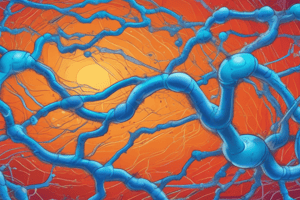Podcast
Questions and Answers
How does binding of a signaling molecule to its receptor affect its activity?
How does binding of a signaling molecule to its receptor affect its activity?
- Binding may activate the protein.
- Binding may inactivate the protein.
- Binding may change its conformation.
- All of the above (correct)
How does phosphorylation of a protein affect its activity?
How does phosphorylation of a protein affect its activity?
- always increases activity
- always decreases the activity
- does not affect the activity
- could increase or decrease the activity (correct)
Which of the following is INCORRECT regarding how enzymes lower the activation energy of a reaction?
Which of the following is INCORRECT regarding how enzymes lower the activation energy of a reaction?
- Enzymes encourage the substrates to change shape toward a transition state that favors the reaction.
- Enzymes align substrates to promote a reaction between them.
- Enzymes rearrange electrons in the substrates in a way that favors the reaction.
- Enzymes reduce the free energy of the products of the reaction. (correct)
The word "nucleoside" refers to_______.
The word "nucleoside" refers to_______.
Disulfide bonds stabilize protein shape outside the cell by__________
Disulfide bonds stabilize protein shape outside the cell by__________
Shown below is the ATP hydrolysis cycle of a motor protein. What sentence BEST describes the state of the motor protein in "C"?
Shown below is the ATP hydrolysis cycle of a motor protein. What sentence BEST describes the state of the motor protein in "C"?
Which method is most suitable for determining the location of a protein inside the cell?
Which method is most suitable for determining the location of a protein inside the cell?
The function of a feedback mechanism is to
The function of a feedback mechanism is to
Which of the following is true about a negative feedback loop?
Which of the following is true about a negative feedback loop?
Which method is used for separating proteins based on specific interactions with other molecules?
Which method is used for separating proteins based on specific interactions with other molecules?
Flashcards are hidden until you start studying
Study Notes
Signaling Molecule Receptor Binding
- Binding of a signaling molecule to its receptor activates or inhibits the receptor's activity, leading to a response in the cell
- This binding causes a conformational change in the receptor, triggering a signal transduction pathway
Protein Phosphorylation
- Phosphorylation of a protein can either activate or inhibit its activity, depending on the protein and the site of phosphorylation
- This post-translational modification can alter the protein's function, localization, or interactions
Enzyme Activation Energy
- Enzymes lower the activation energy of a reaction by forming an enzyme-substrate complex, positioning the substrate for efficient catalysis
- The incorrect statement is that enzymes alter the free energy change (ΔG) of a reaction
Nucleoside Definition
- A nucleoside is a molecule composed of a sugar molecule (ribose or deoxyribose) and a nitrogenous base (A, C, G, T, or U)
Disulfide Bonds
- Disulfide bonds stabilize protein shape outside the cell by forming covalent bonds between cysteine residues
- This strengthens the protein's tertiary structure, making it more resistant to degradation
Motor Protein ATP Hydrolysis Cycle
- In state "C" of the ATP hydrolysis cycle, the motor protein is in a bound state to the microtubule, with ADP bound and no Pi released
Protein Localization
- The most suitable method for determining the location of a protein inside the cell is fluorescence microscopy
- This involves tagging the protein with a fluorescent marker, allowing visualization of the protein's distribution
Feedback Mechanisms
- The function of a feedback mechanism is to maintain homeostasis, regulating a process to achieve a stable outcome
- A negative feedback loop counters the original stimulus, reducing the response and promoting stability
Protein Separation
- The method used for separating proteins based on specific interactions with other molecules is affinity chromatography
- This involves binding the protein to a column with immobilized ligands, allowing separation based on specific interactions
Studying That Suits You
Use AI to generate personalized quizzes and flashcards to suit your learning preferences.


